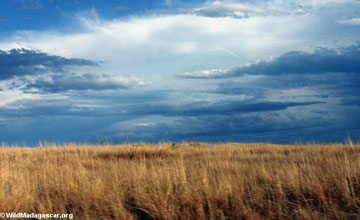Some grasslands resilient against climate change, according to 13 year study
Some grasslands resilient against climate change, according to 13 year study
Jeremy Hance, mongabay.com
July 7, 2008
|
|
In Buxton, England–a spa town lying in the county of Derbyshire–scientists have spent 13 years subjecting grasslands to temperature increases and precipitation shifts consistent with climate change predictions. Considered one of the longest studies of climate change on natural ecosystems, the grasslands of Buxton proved surprisingly resilient to most of the effects of climate change.
Long-term drought did affect the study plots, though the grasslands were unchanged by temperature increases of 3 degrees Celsius in the winter and increases of precipitation in the summer. Drought caused a shift to less-productive, more drought-tolerant plant species. Some species could not survive the drought climate and disappeared from those sites. Yet even the changes in the drought-plots were not drastic, being described by the researchers as “marginal”.
These findings are consistent with the long term ecological changes–or, rather, lack thereof–in the area, the researchers write: “most evidence suggests that, since forest clearance, these grasslands have persisted in their basic form and composition over several centuries through periods of considerable climate variation”. But research from another site has shown that not all grasslands are created equal in their resiliency against climate change.
 |
The Buxton study site’s uniqueness–described by the authors as “ancient, steeply sloping, unfertilized grassland dominated by long-lived, slow-growing evergreen species”–has proven especially important in the research. The grasslands of Buxton are uncultivated and populated by slow-growing species. In contrast, the other site studied was productive grasslands transitioning from cultivation to a wild state in Wytham, England. This site was also subjected to the same climate change-like effects (for five years, instead of thirteen), which significantly changed the vegetation at Wytham, unlike at Buxton, leading the researchers to wonder if ‘unproductive’ grasslands are inherently more resistant to climatic changes than productive ones. If this proves to be the case, researchers speculate that the answer lies in the fact that the unproductive vegetation of Buxton is slow-growing, long-living, and generally adaptable to climate stress.
The grasslands of Buxton are more vulnerable to other changes, such as the artificial addition of nutrients (like those found in fertilizer), overgrazing, and fire. Therefore, ecosystem modification by humans through agricultural, fire, or cattle, in this case, proves a greater threat to these grasslands than global warming.
Despite the fact that Buxton grasslands are resilient to climate change, the authors make it clear that many other ecosystems have shown drastic changes to increased warming and precipitation shifts, citing studies done in the Arctic, the alpine region, Mediterranean grasslands, and, of course, their study of cultivated grasslands in Wytham.